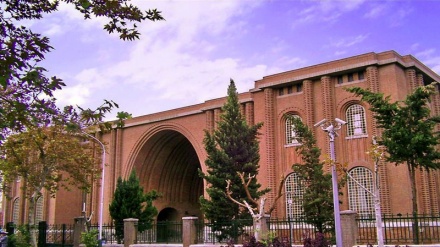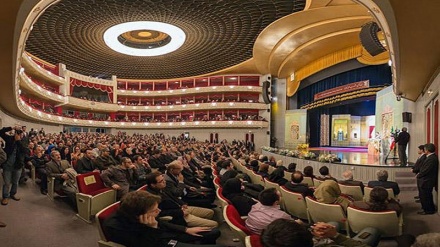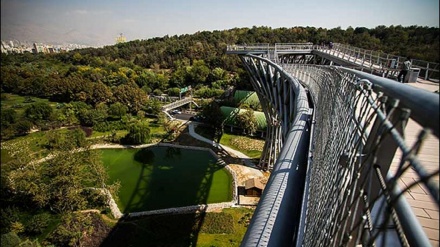Iran Your Attractive Destination (219)
Welcome to another episode of the series Iran Your Attractive Destination. Today, we introduce Aabgineh and Zaman Museums in Tehran.
Aabgineh Museum is the only museum in Iran which displays glassworks, ceramic and crystal-made items, showcasing a number of works of art, remaining from the 1st and 2nd Millenniums BC, up to the Qajarid era. This museum is one of the most popular museums in Iran, given its unique architectural style, and the items which are put on public display in the museum.
This museum is an octagonal-shaped two-story building with a foundation, standing at 1040 square meters. The building also maintains a basement. This building, like many other buildings that have been constructed in Qajarid era, maintains a complex architecture, which is a blend of traditional Iranian and 19th-Century European architectural styles. The building is situated within an orchard that covers an area of 7,000 square meters, capturing the attention of many newcomers and enthusiasts. The unique design and well-maintained gates and windows of the museum are reminders of Saljuqid era architectural style, inspiring contemporary architects to create classic designs.
The building of this museum was constructed in the year 1913 AD, upon the instruction of one of the politicians of Qajarid era, Ahmad Qavam, for personal use. In the year 1975 AD, this building was turned into a museum upon the cooperation of Iranian, Austrian, and German engineers, headed by the designer, Hans Hollein. This museum was inaugurated in the year 1980 AD.
Plasterworks, brickworks, and cut mirrors have adorned this museum, which was registered as an Iranian national heritage in the year 1998 AD.
The glassworks and ceramic items of this valuable treasury have been displayed in this museum within six halls. As it was mentioned, some of the glassworks of this museum belong to 1st and 2nd Millenniums BC, including items remaining from Achaemenian, Parthian, Sassanid and pre-Islamic eras, up to the Islamic era and recent centuries.
The collection of the glassworks and crystal items of this museum depict the terms of development of glassworks industry and the skills of talented Iranian experts. Moreover, some of the crystal items which have been produced in Europe throughout the 18th and 19th Centuries AD have been showcased in the museum.
Some of the ceramic items in this museum date back to pre-historic times. Moreover, the enameled ceramic items, belonging to Islamic era, can be observed in the museum.
The fact of the matter is that this museum introduces the 5,000-year history of glassworks and 10,000-year history of pottery, upon depicting valuable and precious historical and cultural items in a number of interconnected halls and corridors. On the ceramic items which have been displayed in this museum, a number of adages and proverbs, and prayers, in addition to the poems of acclaimed and celebrated Iranian poets, such as Nezami and Ferdowsi, can be observed.
The first and second halls are located on the first floor and other halls are situated on the upper floor. In the second hall, historical glassworks and ceramic items have been showcased for the visitors. The glassworks and ceramic items displayed on the first floor relate to pre-historic times. The most ancient hand-made ceramic item on display in this hall belongs to the Parthian era.
Another hall of this museum displays different types of ceramic items, belonging to 3rd and 4th Centuries AH. The 4th hall showcases the items remaining from Saljuqid era, including items covered and decorated with works of calligraphy.
The 5th hall depicts items which belong to 7th and 8th Centuries AH.
In addition to these items, a number of items of the Safavid and Qajarid eras are also on display in the museum.
Furthermore, this museum maintains a workshop for renovation of items, a pottery workshop, an audio-visual hall, and a library; with books on archeology, history, and arts.
Moreover, in order to introduce and support traditional arts and handicrafts sector, a number of items have been prepared for sales.
Arts such as pottery, glass cutting, and painting are taught within a number of related courses, in this museum.
Zaman Museum is the first time-assessment museum in Iran which was launched in the year 2008 AD. This museum has focused on a number of topics of importance such as the notion of time; the viewpoint of different nations toward the concept of time; and terms of development of watch production industry. Moreover, initial clocks and watches such as sun dials and hour glass, in addition to mechanical watches, and wristwatches are on display in Zaman Museum. Also, part of documents related to Jalali Calendar, have been showcased in the museum.
On the second floor of this museum, some of the most precious wristwatches and calendars are showcased for the visitors.
The foundation of this two-story museum stands at nearly 700 square meters. It has been constructed in a courtyard, which covers nearly 5000 square meters. The construction of this building dates back to 80 years ago. The building was constructed with sun-dried mud bricks and it maintained a wooden skeleton. It has been totally renovated and currently maintains an iron skeleton. The plasterworks which decorate this building are a blend of Iranian and European styles. The facade of the building is a blend of Qajarid and modern styles. The plasterworks which decorate this building have taken ten years to complete.
This museum belongs to Qajarid era and has been enlisted among Iran’s national heritages, in the year 2003 AD.
MR/SS


